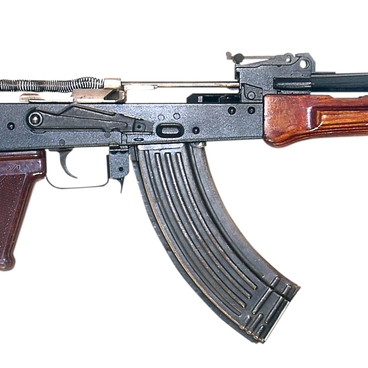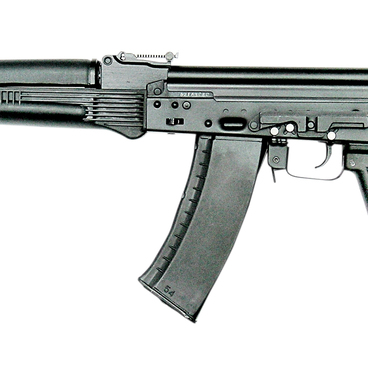Kalashnikov modernized assault rifle (AKM) was designed in 1959 as an upgrade version of AK-47. The developers took into consideration many remarks and suggestions of military units that had been collected for several years after adopting the Kalashnikov assault rifle for service.
The mass of an assault rifle was reduced by almost a quarter — from 4.3 to 3.1 kilograms. Fire accuracy of long bursts was improved. Cold stamping and casting allowed to forego cutting hardware — it was no longer necessary to grind and file metal blanks of rifle parts using process-specialized machines. This technology helped to reduce metal consumption greatly as well as simplify production. Instead of a sword bayonet, new AKM was supplied with a short removable bayonet, which could be used as a knife, a saw and even, when coupled with its scabbard, as wire cutters.
The army valued the updated weapon, and AKM became the blueprint for the standardized system of small arms chambered for the 7.62mm caliber cartridge.
The inventor Mikhail Kalashnikov paid special attention to the weapon development for border troops. He frequently said that he had developed the assault rifle to defend his country and its borders. In the 1970s and 1980s, Kalashnikov often visited army units, naval crews and border posts. The border troops respected the inventor. They had to use the rifles more often than the others — during various incidents at the state border.
Kalashnikov personally presented the Green series AKMs to the frontiersmen who were the best shots and excelled in combat and political training. The rifles of this limited batch were assembled at the Izhmash plant. Their plastic fore-end, handguard, pistol grip, buttstock and magazine were painted green — the color of the border troops. A small plate with the inscription on behalf of Kalashnikov was attached to the right side of the receiver.
A year after receiving the award AKM rifle, soldiers had to either confirm their status of the best shot in the military unit or pass their weapon to a new winner of the competition. The museum funds house numerous photographs of the ceremonies where Mikhail Kalashnikov awarded soldiers from different military units with this assault rifle before the unit formation.
The mass of an assault rifle was reduced by almost a quarter — from 4.3 to 3.1 kilograms. Fire accuracy of long bursts was improved. Cold stamping and casting allowed to forego cutting hardware — it was no longer necessary to grind and file metal blanks of rifle parts using process-specialized machines. This technology helped to reduce metal consumption greatly as well as simplify production. Instead of a sword bayonet, new AKM was supplied with a short removable bayonet, which could be used as a knife, a saw and even, when coupled with its scabbard, as wire cutters.
The army valued the updated weapon, and AKM became the blueprint for the standardized system of small arms chambered for the 7.62mm caliber cartridge.
The inventor Mikhail Kalashnikov paid special attention to the weapon development for border troops. He frequently said that he had developed the assault rifle to defend his country and its borders. In the 1970s and 1980s, Kalashnikov often visited army units, naval crews and border posts. The border troops respected the inventor. They had to use the rifles more often than the others — during various incidents at the state border.
Kalashnikov personally presented the Green series AKMs to the frontiersmen who were the best shots and excelled in combat and political training. The rifles of this limited batch were assembled at the Izhmash plant. Their plastic fore-end, handguard, pistol grip, buttstock and magazine were painted green — the color of the border troops. A small plate with the inscription on behalf of Kalashnikov was attached to the right side of the receiver.
A year after receiving the award AKM rifle, soldiers had to either confirm their status of the best shot in the military unit or pass their weapon to a new winner of the competition. The museum funds house numerous photographs of the ceremonies where Mikhail Kalashnikov awarded soldiers from different military units with this assault rifle before the unit formation.

